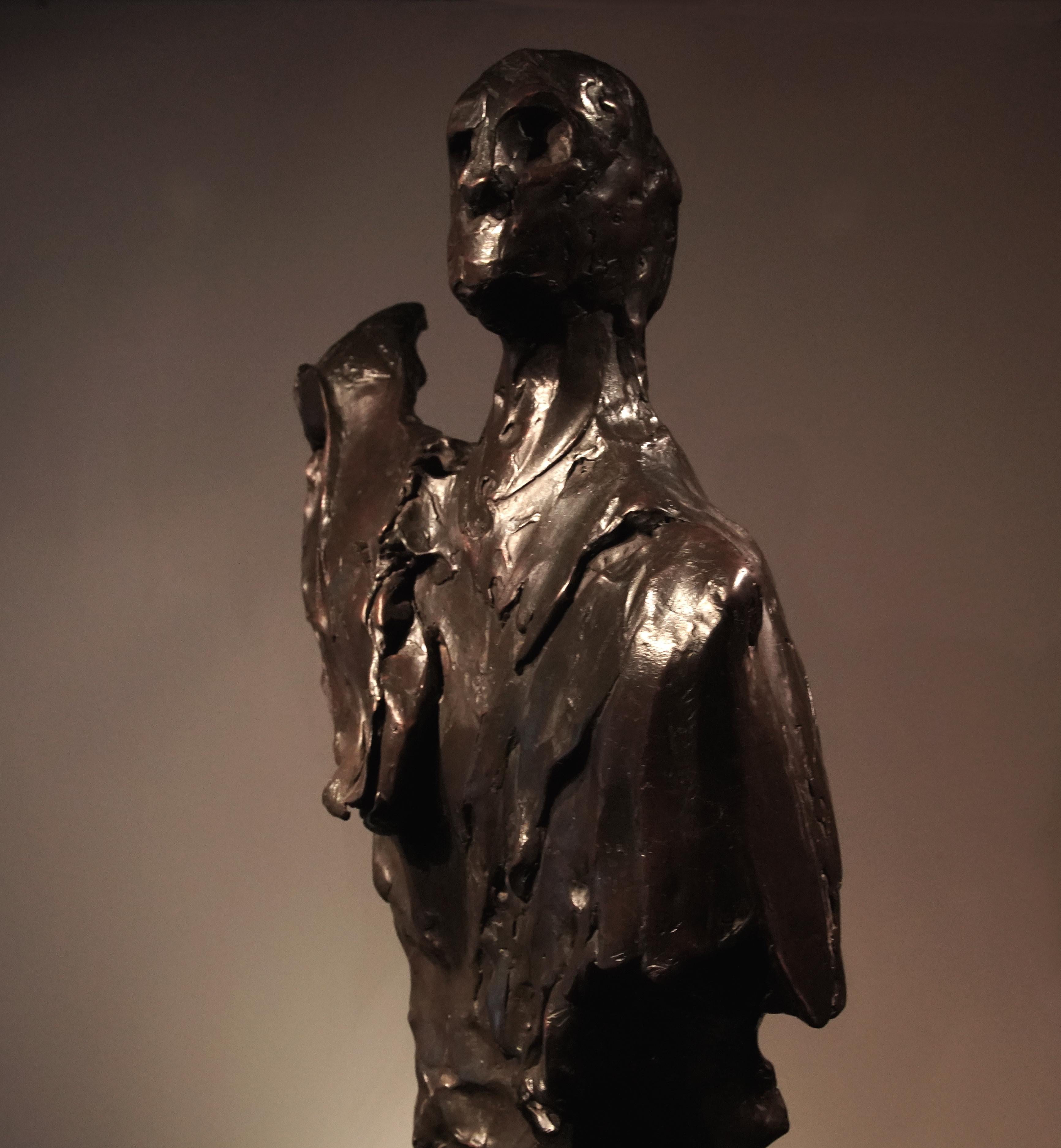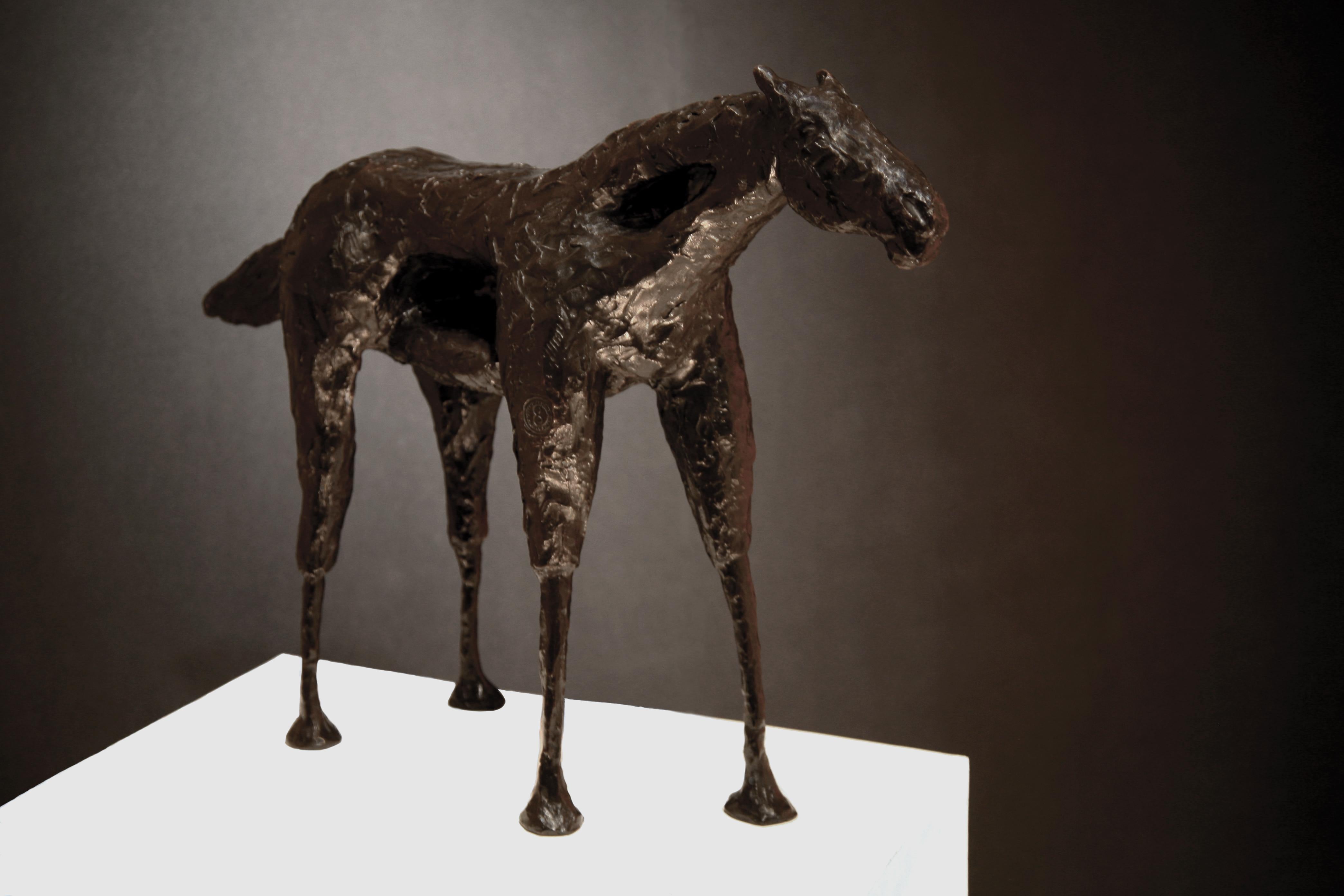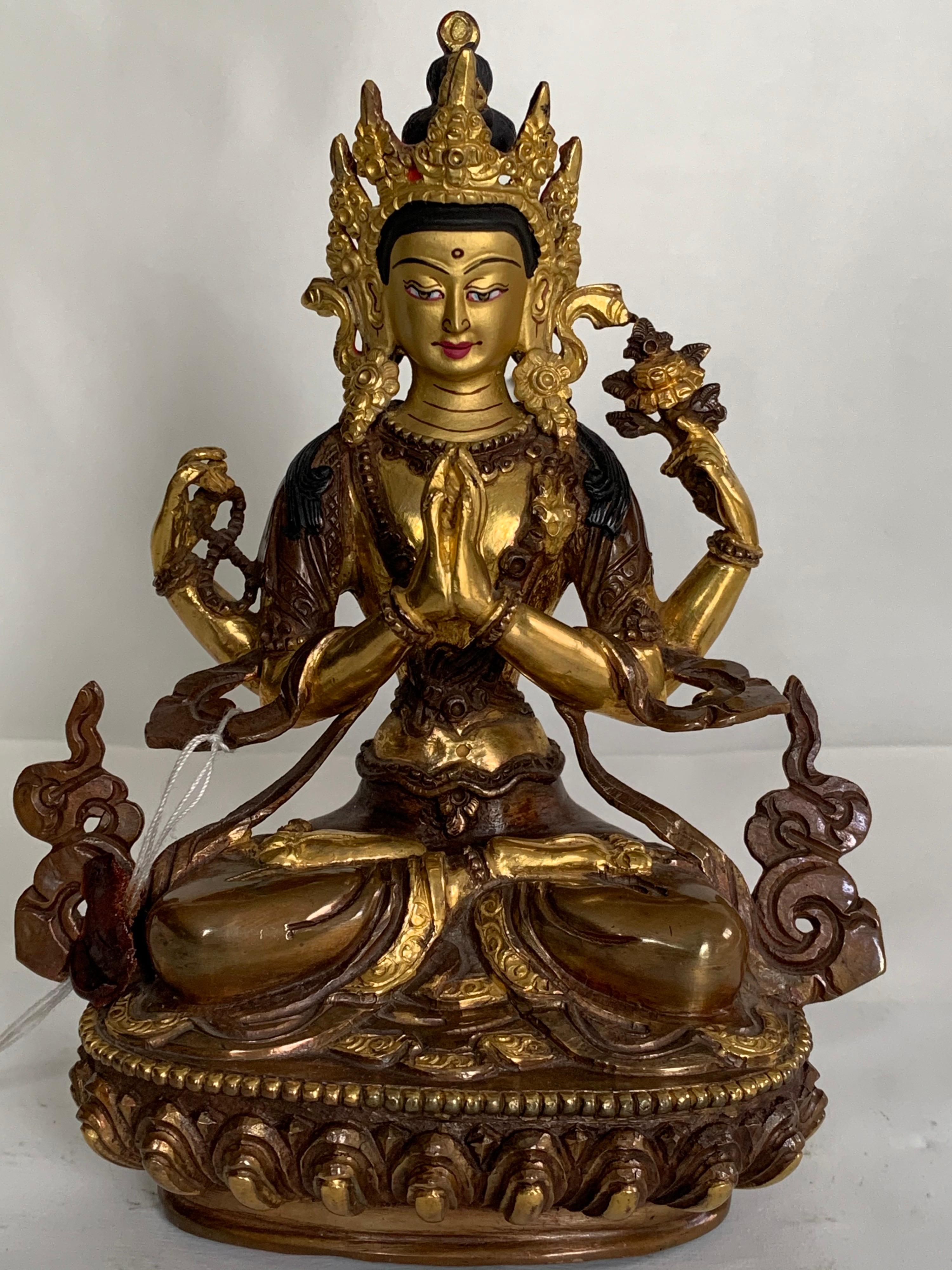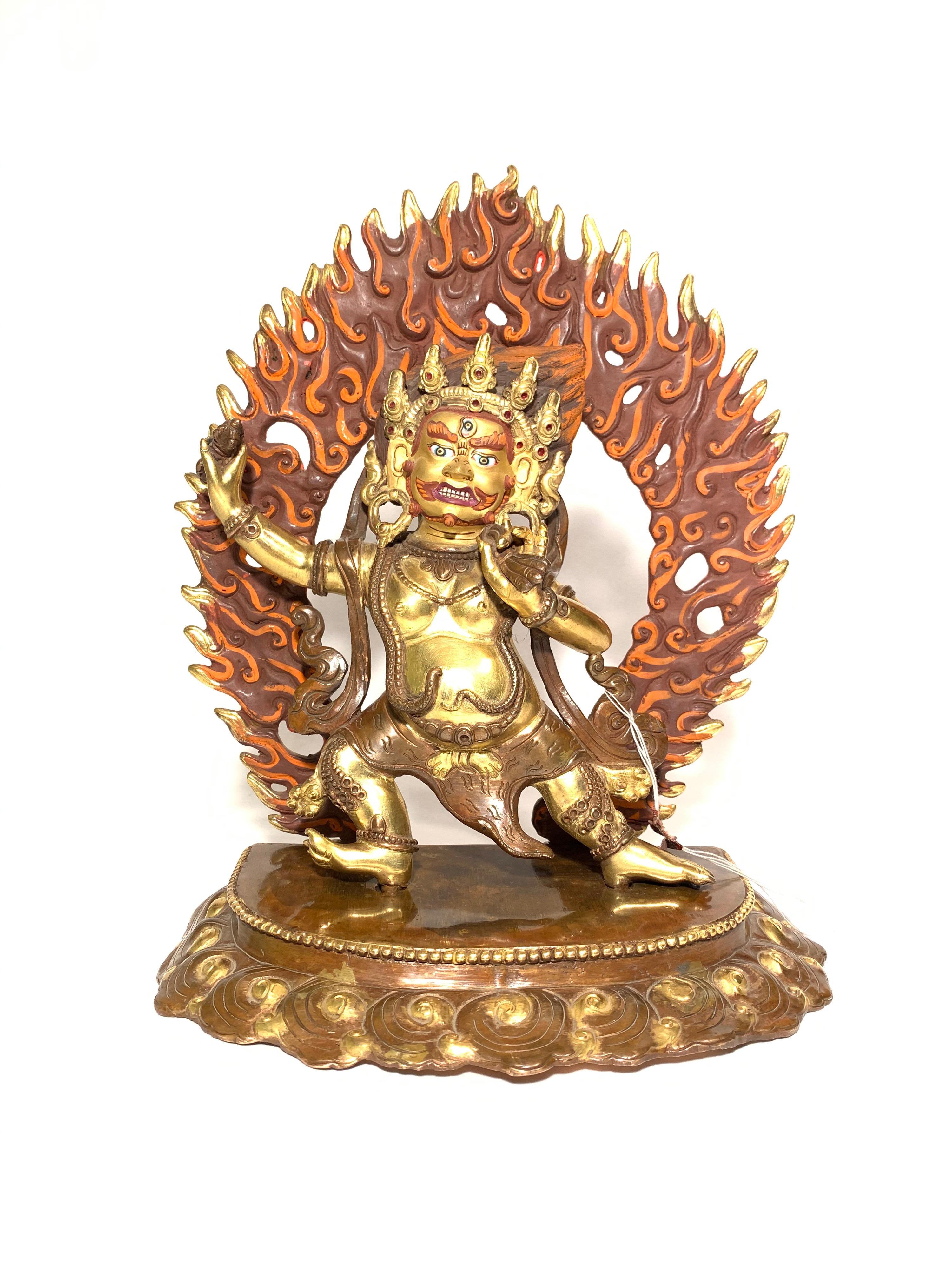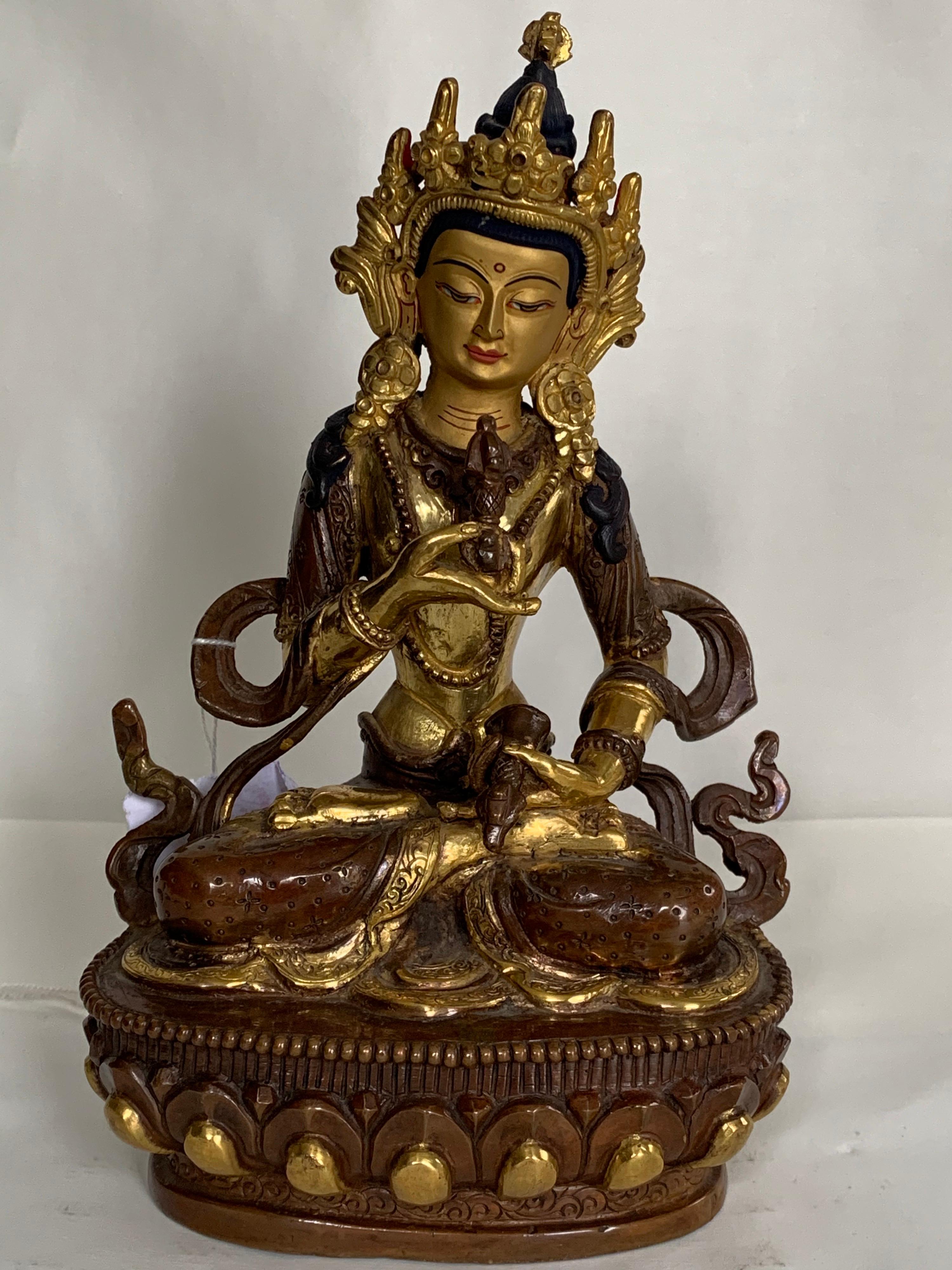Items Similar to Judaica Silvered Copper Repousse Sculpture Relief Plaque Shtetl Yeshiva Bochur
Want more images or videos?
Request additional images or videos from the seller
1 of 5
Arieh MerzerJudaica Silvered Copper Repousse Sculpture Relief Plaque Shtetl Yeshiva Bochur
About the Item
Arieh Merzer was a prominent Israeli artist and metal worker.
Arie Merzer, an artist who worked in hand-hammered copper, was born in Warsaw, Poland in 1905, the scion of a large Hassidic family. He graduated from the Academy of Arts in Warsaw, and became the pupil of Professor Adam Richtarsky. He later worked with a group of Jewish artists who wanted to resuscitate the ancient oriental-Jewish craft of hand-hammering metal (metaloplastics), which was passed on to us as a legacy by far-off generations from the time of the Bible.
In 1928 Arieh Merzer exhibited his works in Warsaw for the first time. From 1930 he lived and worked in Paris. He was one of the Jewish artists who gathered there and were known as the Jewish 'Ecole de Paris.' Merzer regularly exhibited in the well-known 'Salon d'Automne' and 'Salon des Tuileries,' as well as in solo exhibitions in Paris and throughout France.
Arieh Merzer's work was highly acclaimed well before the Holocaust, before it became a memorial to a world destroyed. He portrayed the story of the Jewish spirit on copper, on silver, and on gold: stories from the Bible, the life-styles of the Jews in their shtetls and ghettos, of Chassidim and Kabbalists of renown, of wars of liberation and revival.
A special stress was placed on the link between the new Jewish experience and its historical nucleus. His major innovation was the moulding of mystic and traditional Jewish motifs, that surrounded the Holy Ark in Europe's burning synagogues, and presenting the results before the world of modern art. As a result he became generally recognized as an international Jewish artist.
In 1943, when France was conquered by the Nazis, Arieh Merzer escaped from a concentration camp, and after a stint in the maquis, he crossed the border into Switzerland and was sent to a labor camp. Later, he arrived in Geneva, where an album of sketches of his works was put out. In 1945 he made aliyah to Israel with his family, settled in Safed, and helped to found the Artists' Quarter there.
Arieh Merzer lived and worked in Israel for twenty-one years. His exhibitions in the country include: 1946 in the Tel Aviv Museum; 1947 in the Pevsner Artists' Pavilion in Haifa; 1951 in the Artists' Pavilion in Tel Aviv; 1955 in the Museum for Modern Art in Haifa; 1955 in the Artists' Pavilion in Jerusalem; and 1957 in the Tel Aviv Museum. His works were also on permanent show in his atelier in Safed. He was awarded prizes, including: the Herman Struck prize in 1946; the Dizengoff prize in 1951 and then again in 1965; and the Mayor of Haifa's prize in 1954. His works appear in numerous museums and collections throughout the country and abroad. His heart stopped beating on the eve of Holocaust Day, 1966.
Arieh Merzer, who was brought up in a Hassidic family, was drawn to the world of art from an early age; he was influenced by the moods and new ideals of the socialist circles and prepared himself to study art in the academy. On Passover eve , after clearing out the bread, while the rest of the household was busy preparing for the Holiday, a book fell from the bookcase and from out its pages flew dozens of sketches and drawings of nudes that the young Arieh had prepared for his folio for the entrance examinations to the academy. His sisters tore up the drawings with cries of treyfe treyfe (ritually non-kosher) and many months' hard work went down the drain. As a result of this, he left his home at the age of fifteen, and later joined a group of young artists who wanted to revive the ancient art of hand-hammered copper - metaloplastics - bequeathed to them by past generations who lived in Bible times.
Thus did he part from his family - mother, father, thirteen brothers and sisters - who all perished in the Holocaust. He alone survived, and made an oath that he would commemorate in copper all who had died.
Exhibited: The ''Shtetl'' Yad Vashem Museum, Jerusalem, 1965
Artists: Jankel Adler, Isidor Aschheim, Josef Budko, Samuel Hirszenberg, Arieh Merzer, Jeheskel Kirszenbaum and Jakob Steinhardt.
- Creator:Arieh Merzer (1905 - 1966, French)
- Dimensions:Height: 9 in (22.86 cm)Width: 7.5 in (19.05 cm)
- Medium:
- Period:
- Condition:minor wear.
- Gallery Location:Surfside, FL
- Reference Number:1stDibs: LU38213134632
About the Seller
4.9
Platinum Seller
These expertly vetted sellers are 1stDibs' most experienced sellers and are rated highest by our customers.
Established in 1995
1stDibs seller since 2014
1,546 sales on 1stDibs
Typical response time: 1 hour
- ShippingRetrieving quote...Ships From: Surfside, FL
- Return PolicyA return for this item may be initiated within 3 days of delivery.
More From This SellerView All
- Bronze Sculpture Relief Rhinoceros with Tree American Modernist Leonard BaskinBy Leonard BaskinLocated in Surfside, FLLeonard Baskin (1922-2000) Fruitfulness From Permanence signed, edition 3/8 Bronze, 1967 19.5 X 16 X 1.5 inches The inspiration for this work was a Bernini sculpture Elephant Carrying Obelisk, a 17th century commission outside an ancient temple dedicated to Minerva the goddess of wisdom. It was one of several works from 1967 on a theme of continuity Leonard Baskin (August 15, 1922 – June 3, 2000) was an American sculptor, illustrator, wood-engraver, printmaker, graphic artist, writer and teacher. Baskin was born in New Brunswick, New Jersey. While he was a student at Yale University, he founded Gehenna Press, a small private press specializing in fine book production. From 1953 until 1974, he taught printmaking and sculpture at Smith College in Northampton, Massachusetts. Subsequently Baskin also taught at Hampshire College in Amherst, Massachusetts. He lived most of his life in the U.S., but spent nine years in Devon at Lurley Manor, Lurley, near Tiverton, close to his friend Ted Hughes, for whom he illustrated Crow. Sylvia Plath dedicated Sculpto to Leonard Baskin in her famous work, The Colossus and Other Poems (1960). The Funeral Contege (1997) bronze, Franklin Delano Roosevelt Memorial, Washington, D.C. His public commissions include a bas relief for the Franklin Delano Roosevelt Memorial and a bronze statue of a seated figure, erected in 1994 for the Holocaust Memorial in Ann Arbor, Michigan. His works are owned by many major museums including the Metropolitan Museum of Art, the Museum of Fine Arts, Boston, the Museum of Modern Art, the Art Institute of Chicago, the Boca Raton Museum of Art, the British Museum, the Honolulu Museum of Art, the Udinotti Museum of Figurative Art and the Vatican Museums. The archive of his work at the Gehenna Press was acquired by the Bodleian Library at Oxford, England, in 2009. The McMaster Museum of Art in Hamilton, Ontario owns over 200 of his works (some religious and biblical), most of which were donated by his brother Rabbi Bernard Baskin. Contemporary Religious Imagery in American Art. Catalog for an exhibition held at the Ringling Museum of Art, March 1-31, 1974. Artists represented: David Aronson, Leonard Baskin, Max Beckmann, Hyman Bloom, Fernando Botero, Paul Cadmus, Marvin Cherney, Arthur G. Dove, Philip Evergood, Adolph Gottlieb, Jonah Kinigstein, Arman, Rico Lebrun, Jack Levine, Louise Nevelson, Barnett Newman, Abraham Rattner, Ben Shahn, Mark Tobey, Max Weber, William Zorach and others.In 1955, he was one of eleven New York artists featured in the opening exhibition at the Terrain Gallery, they showed many great artists, Chaim Koppelman, for many years, headed the gallery's Print Division; printmakers such as Will Barnet, Leonard Baskin, Robert Conover, Edmond...Category
20th Century Modern Figurative Sculptures
MaterialsBronze
- Large Israeli Colorful Metal Wall Sculpture Painting Circus Scene Calman ShemiBy Calman ShemiLocated in Surfside, FLCalman Shemi (1939-) Laser cut metal wall sculpture 3D Titled "Circus" Signed on the front lower left edge, and signed, numbered, and titled verso. Marked, Jerusalem Limited edition, 2/99 (I don't know how many were actually made) Approx. 34.5" x 35.5" Depicts weightlifter, acrobats, figure on unicycle, clown with umbrella, and acrobat under the circus big top...Category
1990s Contemporary Figurative Sculptures
MaterialsMetal
- German Expressionist Bronze Relief Plaque Mans Best Friend, a Man and His DogLocated in Surfside, FLMans Best Friend C.M. Junghans 1985 This is done in a German Expressionist style. It is bronze over some sort of fill. It depicts a man gentleman and his dog. a Cocker Spaniel or Co...Category
20th Century Expressionist Figurative Sculptures
MaterialsBronze
- Abstract Metal Sculpture Navajo Native American Indian Art Woman Pollen KeeperBy Melanie YazzieLocated in Surfside, FLMelanie Yazzie (1966-) Pollen Keeper II (maquette) Powder-coated metal, 2008 Hand signed, titled, dated and numbered 2/30, attributed, titled, dated and numbered again to paper label Mounted to a white composition plinth Provenance: The Freund Family Collection Melanie Yazzie is a Navajo sculptor, painter, printmaker, and professor. She teaches at the University of Colorado at Boulder. Yazzie was born in 1966 in Ganado, Arizona, United States. She is Navajo of the Áshįįhí, born for Tó Dichʼíinii. She grew up on the Navajo Nation. Although she grew up on the Navajo Nation, Melanie Yazzie is of the Salt Water Clan born for the Bitter Water Clan. She first studied art at the Westtown School in Pennsylvania. Yazzie earned a BA in Studio Art with a minor in Spanish from Arizona State University in 1990 and an MFA in printmaking from the University of Colorado at Boulder in 1993. Melanie Yazzie works a wide range of media that include printmaking, painting, sculpting, and ceramics, as well as installation art. Her art is accessible to the public on many levels and the main focus is on connecting with people and educating people about the contemporary status of one indigenous woman and hoping that people can learn from her experience. Her subject matter is significant because the serious undertones reference native postcolonial dilemmas. Melanie's work focuses primarily on themes of indigenous people. Her work often brings images of women from many indigenous cultures to the forefront. Thus her work references matrilineal systems and points to the possibility of female leadership. Yazzie is known for her multilayered monotype prints that focus on storytelling and reflect her dreamtime friends and companions. The works are filled with colors and textures that reflect different world. The works are made with stencils and often she is printing with soy based inks called Akua inks that are safe for the artist and the environment. The works most often are printed on Arches 88 due to the absorbing quality of that 100% rag paper. It is a fine art paper made in France and very soft to the touch. It is a paper designed originally for screen printing but is the perfect surface for many of the works Yazzie creates. The works often are monotypes as opposed to monoprints. So the works are a one of a kind work of art and not made in multiples. She is a Professor and Head of Printmaking at the University of Colorado at Boulder. She teaches printmaking courses and travels extensively to indigenous communities within the United States and abroad. She can always be found through the University of Colorado Art and Art History Department. In addition to teaching at the Institute of American Indian Arts, the College of Santa Fe (now Santa Fe University of Art and Design), Boise State University, and the University of Arizona, Yazzie has taught at the Pont Aven School of Contemporary Art in France. Yazzie has led over 100 international print exchanges over a 20-year time period. Many of these exchanges include artists from Siberia, Japan, New Zealand, Australia, Canada, Mexico, and Germany. In 2012, the Denver Art Museum welcomed Yazzie as artist-in-residence, making her the first in the Native Arts department. A selection of major exhibitions from the 1990s to present include "Between Two Worlds" (2008) at Arizona State University, "Traveling" at the Heard West Museum (2006), "About Face: Self-Portraits by Native American, First Nations, and Inuit Artists" at the Wheelwright Museum (2005), "Making Connections" (2002) in Bulova, Russia, "Navajo in Gisborne" (1999) in Gisborne, New Zealand and "Watchful Eyes" (1994) at the Heard Museum. In September 2013 she co-curated the exhibition "Heart Lines: Expressions of Native North American Art" in Colorado University Art Museum, partially based on her private collection and including her work "Pollen Girl". Artists featured: Norman Akers, Maile Andrade, Kenojuak Ashevak, Pitseolak Ashoona, Corwin Clairmont, Jimmie Durham...Category
Early 2000s Contemporary Abstract Sculptures
MaterialsMetal
- Bronze Sculpture Figure with Beast American Modernist Leonard Baskin Museum ArtBy Leonard BaskinLocated in Surfside, FLLeonard Baskin, American 1922-2000 Homage to the Un-American Activities Committee Bronze relief sculpture plaque This is not editioned, nor signed or numbered, on the piece but according to the catalog there was 12 or less. A number of these are in museum and university art collections and one of them was exhibited at MoMA NY. This was done to commemorate the communist witch hunts of the Mccarthy era. An important, historic piece. Leonard Baskin (August 15, 1922 – June 3, 2000) was an American sculptor, illustrator, wood-engraver, printmaker, graphic artist, writer and teacher. Baskin was born in New Brunswick, New Jersey. While he was a student at Yale University, he founded Gehenna Press, a small private press specializing in fine, small edition, book production. From 1953 until 1974, he taught printmaking and sculpture at Smith College in Northampton, Massachusetts. Subsequently Baskin also taught at Hampshire College in Amherst, Massachusetts. He lived most of his life in the U.S., but spent nine years in Devon at Lurley Manor, Lurley, near Tiverton, close to his friend Ted Hughes, for whom he illustrated Crow. Sylvia Plath dedicated Sculpto to Leonard Baskin in her famous work, The Colossus and Other Poems (1960). The Funeral Cortege (1997) bronze, Franklin Delano Roosevelt Memorial, Washington, D.C. His public commissions include a bas relief for the Franklin Delano Roosevelt Memorial and a bronze statue of a seated figure, erected in 1994 for the Holocaust Memorial in Ann Arbor, Michigan. His works are owned by many major museums including the Metropolitan Museum of Art, the Museum of Fine Arts, Boston, the Museum of Modern Art, the Art Institute of Chicago, the Boca Raton Museum of Art, the British Museum, the Honolulu Museum of Art, the Udinotti Museum of Figurative Art and the Vatican Museums. The archive of his signed work at the Gehenna Press was acquired by the Bodleian Library at Oxford, England, in 2009. The McMaster Museum of Art in Hamilton, Ontario owns over 200 of his works (some religious and biblical), most of which were donated by his brother Rabbi Bernard Baskin. Contemporary Religious Imagery in American Art. Catalog for an exhibition held at the Ringling Museum of Art, March 1-31, 1974. Artists represented: David Aronson, Leonard Baskin, Max Beckmann, Hyman Bloom, Fernando Botero, Paul Cadmus, Marvin Cherney, Arthur G. Dove, Philip Evergood, Adolph Gottlieb, Jonah Kinigstein, Arman, Rico Lebrun, Jack Levine, Louise Nevelson, Barnett Newman, Abraham Rattner, Ben Shahn, Mark Tobey, Max Weber, William Zorach and others.In 1955, he was one of eleven New York artists featured in the opening exhibition at the Terrain Gallery, they showed many great artists, Chaim Koppelman, for many years, headed the gallery's Print Division; printmakers such as Will Barnet, Leonard Baskin, Robert Conover, Edmond Casarella...Category
1950s Modern Figurative Sculptures
MaterialsBronze
- Bronze Female Nude Sculpture Modernist, WPA, New York Chelsea Hotel ArtistBy Eugenie GershoyLocated in Surfside, FLEugenie Gershoy (January 1, 1901 – May 8, 1986) was an American sculptor and watercolorist. Eugenie Gershoy was born in Krivoy Rog, Russia (Krivoi Rog, Ukraine) and emigrated to New York City in the United States as a child in 1903. Considered somewhat of a child prodigy, Gershoy was copying Old Master drawings at the age of 5. Her interest and talent in art was encouraged from a very young age. Aided by scholarships, she studied at the Art Students League under Alexander Stirling Calder, Leo Lentelli, Kenneth Hayes Miller, and Boardman Robinson. Around this time, she created a group of portrait figurines of her fellow artists, including Arnold Blanch, Lucile Blanch, Raphael Soyer, William Zorach, Concetta Scaravaglione, and Emil Ganso, which were exhibited as a group at the Whitney Museum of American Art. At age 17, she was awarded the Saint-Gaudens Medal for fine draughtsmanship. Early in her career she became an active member of the Woodstock art colony. In Woodstock she experimented by sculpting in the profusion of indigenous materials that she found. Working with fieldstone, oak and chestnut, Gershoy created works based on classic formulae. As she became more interested in the dynamism of everyday life, she found that these materials and her idiom were too restrictive. By the time Gershoy came to Woodstock in 1921 her own individual artistic style was already evident in her sculptures. Eugenie Gershoy worked in stone, bronze, terracotta, plaster and papier-mache. Gershoy’s sculptures were mainly figurative in nature and many of her artist peers such as Carl Walters, Raphael and Moses Soyer, William Zorach and Lucille Blanch, became her subjects. Eugenie Gershoy’s works on paper should not be overlooked. She was the winner of the Gaudens Medal for Fine Draughtsmanship at the tender age of 17. Gershoy married Jewish Romanian-born artist Harry Gottlieb. In the late 1920s and early 1930s, the pair kept a studio in Woodstock, New York. There, Gershoy was influenced by sculptor John Flanagan, who lived and worked nearby. From 1936 to 1939, Gershoy worked for the WPA Federal Art Project. She collaborated with Max Spivak on murals for the children's recreation room of the Queens Borough Public Library in Astoria, New York. She developed a mixture of wheat paste, plaster, and egg tempera, which she used in polychrome papier-mâché sculptures; she was the only New York sculptor to work in polychrome at this time. She also designed cement and mosaic sculptures of animals and figures to be placed in New York City playgrounds. Alongside others employed by the FAP, she participated in a sit-down strike in Washington, DC, to advocate for better pay and improved working conditions for the projects' artists. Gershoy's first solo exhibition was held at the Robinson Gallery in New York in 1940. She moved to San Francisco in 1942, and began teaching ceramics at the California School of Fine Arts in 1946. In 1950, she studied at the artists' colony at Yaddo. Gershoy traveled extensively throughout her life. She visited England and France in the early 1930s, and worked in Paris in 1951. She traveled to Mexico and Guatemala in the late 1940s, and also toured Africa, India, and the Orient in 1955. In 1977, Gershoy dedicated a sculpture to Audrey McMahon, who was actively involved in the creation of the Federal Art Project and served as its regional director in New York, in recognition of the work McMahon provided struggling artists in the 1930s. Gershoy's work is in the collections of the Whitney Museum of American Art, the Metropolitan Museum of Art, and the Smithsonian American Art Museum. Her papers are held at Syracuse University Grant Arnold introduced her to lithography in 1930 and Gershoy depicted many scenes of Woodstock artists and their daily activities through this medium. From 1942 to 1966 Gershoy lived and painted in San Francisco where she taught at the San Francisco Art Institute. She traveled extensively, filling sketchbooks with scenes of Mexico, France, Spain, Africa and India. During her later years Eugenie Gershoy returned to New York City and concentrated on numerous well received exhibitions. Her last exhibition in at Sid Deutsch Gallery included many of the sculptures that were later exhibited in the Fletcher Gallery. John Russell, former chief critic of fine arts for the New York Times, writes about the 1986 Sid Deutsch exhibition: “As Eugenie Gershoy won the Saint-Gaudens Medal for fine draftsmanship as long ago as 1914 and since 1967 has had 15 papier-mache portrait figures suspended from the ceiling of the lobby of the Hotel Chelsea, she must be ranked as a veteran of the New York scene. Her present exhibition includes not only the high-spirited papier-mache sculptures for which she is best known but a group of small portraits of artists, mostly dating from the 30’s, that is strongly evocative.” Eugenie Gershoy is an artist to take note of for several reasons. She was a woman who received great awards and recognition during a time when most female artists were struggling to hold their own against their male counterparts. As a young girl she won a scholarship to the Arts Student League where she met Hannah Small...Category
Mid-20th Century American Modern Nude Sculptures
MaterialsBronze
You May Also Like
- Bronze sculpture “Painted Man”By Frank ArnoldLocated in Fresno, CAFrank Arnold is thought by many to be one of the foremost abstract figurative painters and sculptors of our time. He is a living master whose work is considered to be both personal a...Category
21st Century and Contemporary Figurative Sculptures
MaterialsBronze
- Caballo Arroyo (Bronze horse sculpture by Frank Arnold)By Frank ArnoldLocated in Fresno, CAFrank Arnold is thought by many to be one of the foremost abstract figurative painters and sculptors of our time. He is a living master whose work is considered to be both personal a...Category
21st Century and Contemporary Abstract Figurative Sculptures
MaterialsBronze
- NeuvoaBy Frank ArnoldLocated in Fresno, CAFrank Arnold is thought by many to be one of the foremost abstract figurative painters and sculptors of our time. He is a living master whose work is considered to be both personal a...Category
21st Century and Contemporary Abstract Abstract Sculptures
MaterialsBronze
- Chengrishi Statue 6 Inch with 24K Gold Handcrafted by Lost Wax ProcessLocated in TRUMBULL, CTThis statue is handcrafted by lost wax process which is one of the ancient process of metal craft. Chengrishi is seated in "Padmasana" or lotus pose with two hands in "Namaskar Mudra...Category
21st Century and Contemporary Other Art Style Figurative Sculptures
MaterialsCopper
- Vajrapani Statue 10 Inch with 24K Gold Handcrafted by Lost Wax ProcessLocated in TRUMBULL, CTHandcrafted Vajrapani statue is made by lost wax process which is one of the ancient method of metal craft. It has a halo of fire flames behind the figure. The statue has a overlay o...Category
21st Century and Contemporary Other Art Style Figurative Sculptures
MaterialsCopper
- Vajrasattva Statue 7.5 Inch with 24K Gold Handcrafted by Lost Wax ProcessLocated in TRUMBULL, CTThis statue is handcrafted by lost wax process which is one of the ancient process of metal craft. Vajrasattva is seated on lotus with one hand holding a Vajra and the other hand a b...Category
21st Century and Contemporary Abstract Figurative Sculptures
MaterialsCopper

